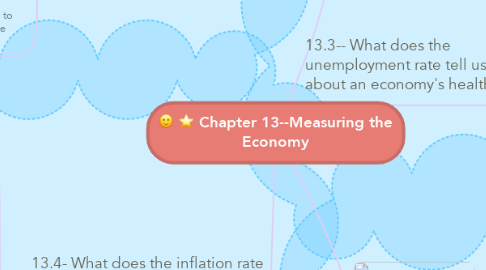Chapter 13--Measuring the Economy
by Catalina Teuber

1. 13.2--How do economists measure the size of an economy?
1.1. -
1.1.1. By studingy the economic decision making of individuals
1.2. Economists calculate GDP by measuring expenditures on goods and services.
1.3. By studying the workings of the economy as a whole
1.4. GDP: he market value of all final goods and services produced within a country
1.5. Market value: the price buyers are willing to pay for a good or service in a competitive market
2. 13.4- What does the inflation rate reveal about an economy's health?
2.1. By gathering information on Americans’ cost of living
2.2. By studying the cost of buying the goods and services that households like yours purchase every day
2.3. Consumer price index: a measure of price changes in consumer goods and services over time; the CPI shows changes in the cost of living from year to year
2.3.1. he inflation rate is usually a positive number, meaning that the overall price level is rising.
2.4. Deflation: a fall in the price of goods and services; the opposite of inflation
2.5. The inflation rate is usually a positive number, meaning that the overall price level is rising.
2.6. http://www.theguardian.com/news/datablog/2014/aug/19/inflation-what-does-it-mean-for-you
2.7. Even though the rate of inflation has slowed down, people still have to contribute to the economic growth do reduce the inflation rate.
3. 13.3-- What does the unemployment rate tell us about an economy's health?
3.1. When business is booming, the number falls.
3.2. The official unemployment rate serves as a fairly good indicator of conditions in the labor market.
3.3. The smaller the number of people who are working, the fewer goods the economy can generate.
3.4. Unemployment rate: the percentage of the labor force that is not employed but is actively seeking work
3.5. Natural rate of unemployment: the percentage of the labor force without work when the economy is at full employment.
4. 13.5-- How does the business cycle relate to Economic health?
4.1. The phases of the business cycle include a period of growth and a period of decline, as well as the turning points that mark the shift from one period to the next.
4.2. The term business cycle implies that expansions and contractions occur at regular, predictable intervals.
4.3. Business cycles are popularly known as periods of boom and bust
4.4. Business cycle: a recurring pattern of growth and decline in economic activity over time
4.5. depression: a prolonged economic downturn characterized by plunging real GDP and extremely high unemployment


